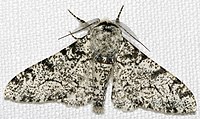
Photo from wikipedia
DNA metabarcoding is increasingly used in dietary studies to estimate diversity, composition and frequency of occurrence of prey items. However, few studies have assessed how technical and biological replication affect… Click to show full abstract
DNA metabarcoding is increasingly used in dietary studies to estimate diversity, composition and frequency of occurrence of prey items. However, few studies have assessed how technical and biological replication affect the accuracy of diet estimates. This study addresses these issues using the European free‐tailed bat Tadarida teniotis, involving high‐throughput sequencing of a small fragment of the COI gene in 15 separate faecal pellets and a 15‐pellet pool per each of 20 bats. We investigated how diet descriptors were affected by variability among (a) individuals, (b) pellets of each individual and (c) PCRs of each pellet. In addition, we investigated the impact of (d) analysing separate pellets vs. pellet pools. We found that diet diversity estimates increased steadily with the number of pellets analysed per individual, with seven pellets required to detect ~80% of prey species. Most variation in diet composition was associated with differences among individual bats, followed by pellets per individual and PCRs per pellet. The accuracy of frequency of occurrence estimates increased with the number of pellets analysed per bat, with the highest error rates recorded for prey consumed infrequently by many individuals. Pools provided poor estimates of diet diversity and frequency of occurrence, which were comparable to analysing a single pellet per individual, and consistently missed the less common prey items. Overall, our results stress that maximizing biological replication is critical in dietary metabarcoding studies and emphasize that analysing several samples per individual rather than pooled samples produce more accurate results.
Journal Title: Molecular Ecology
Year Published: 2019
Link to full text (if available)
Share on Social Media: Sign Up to like & get
recommendations!